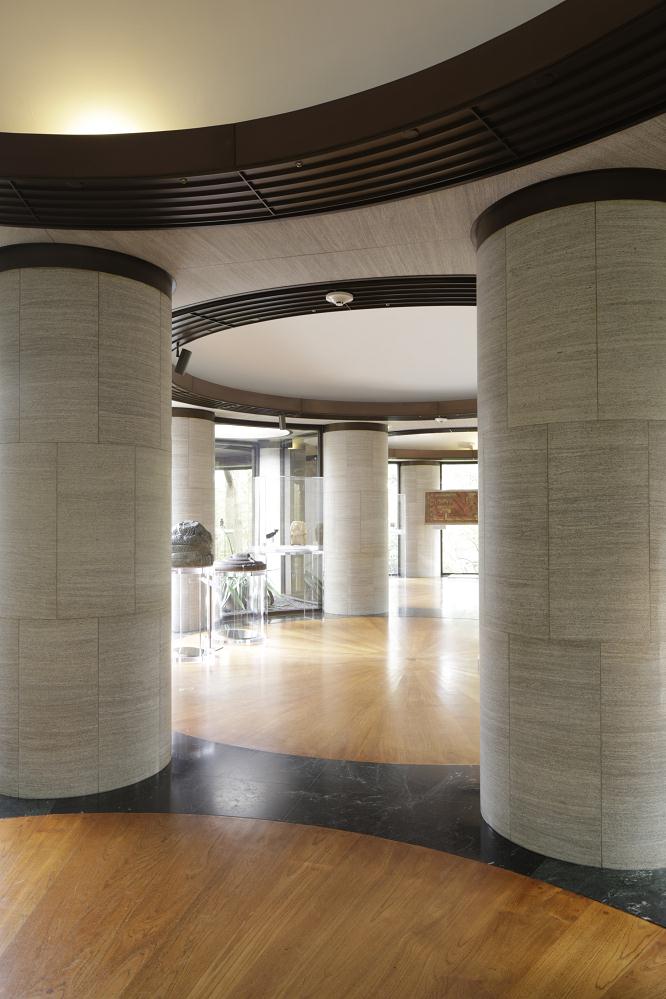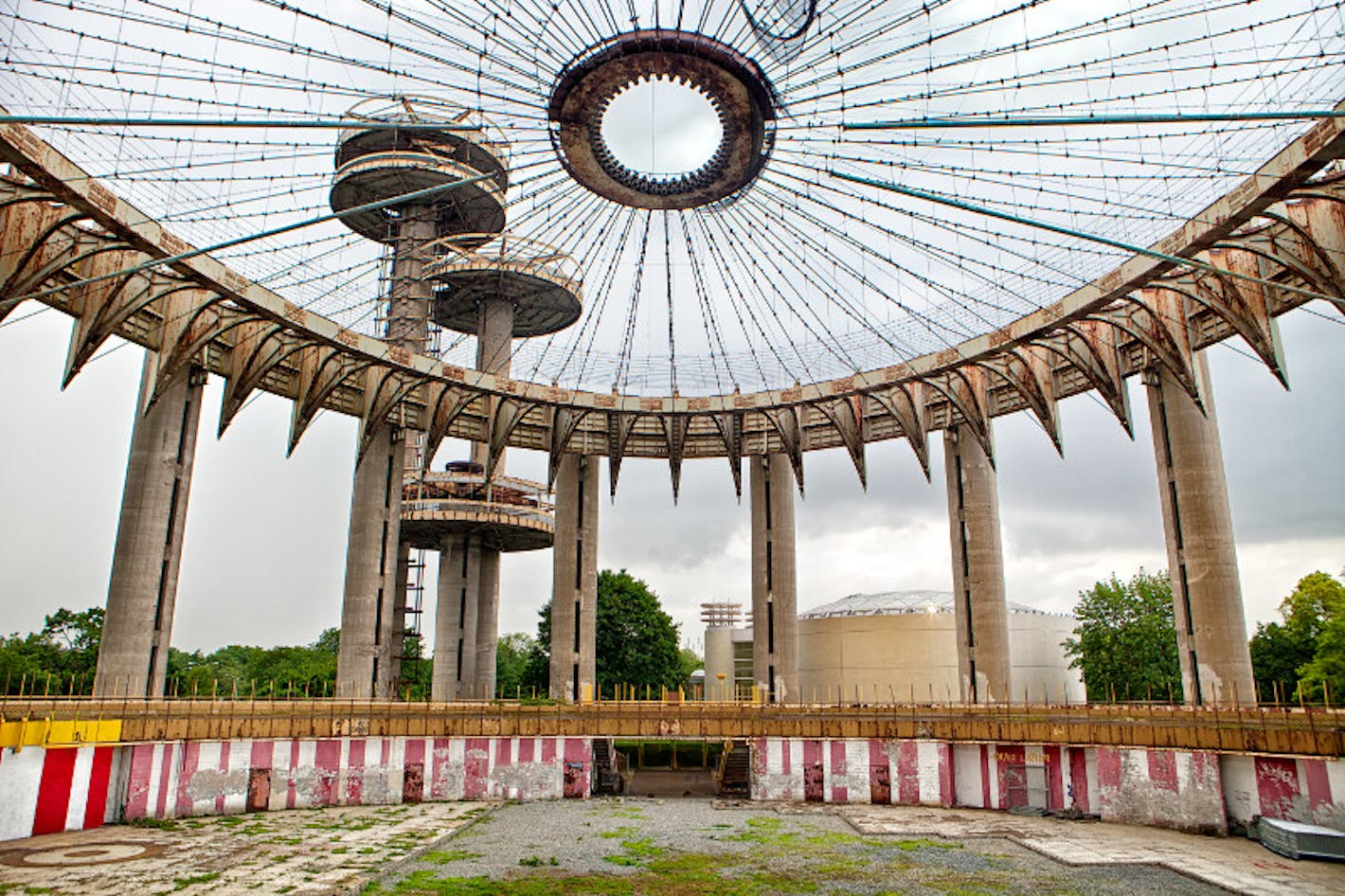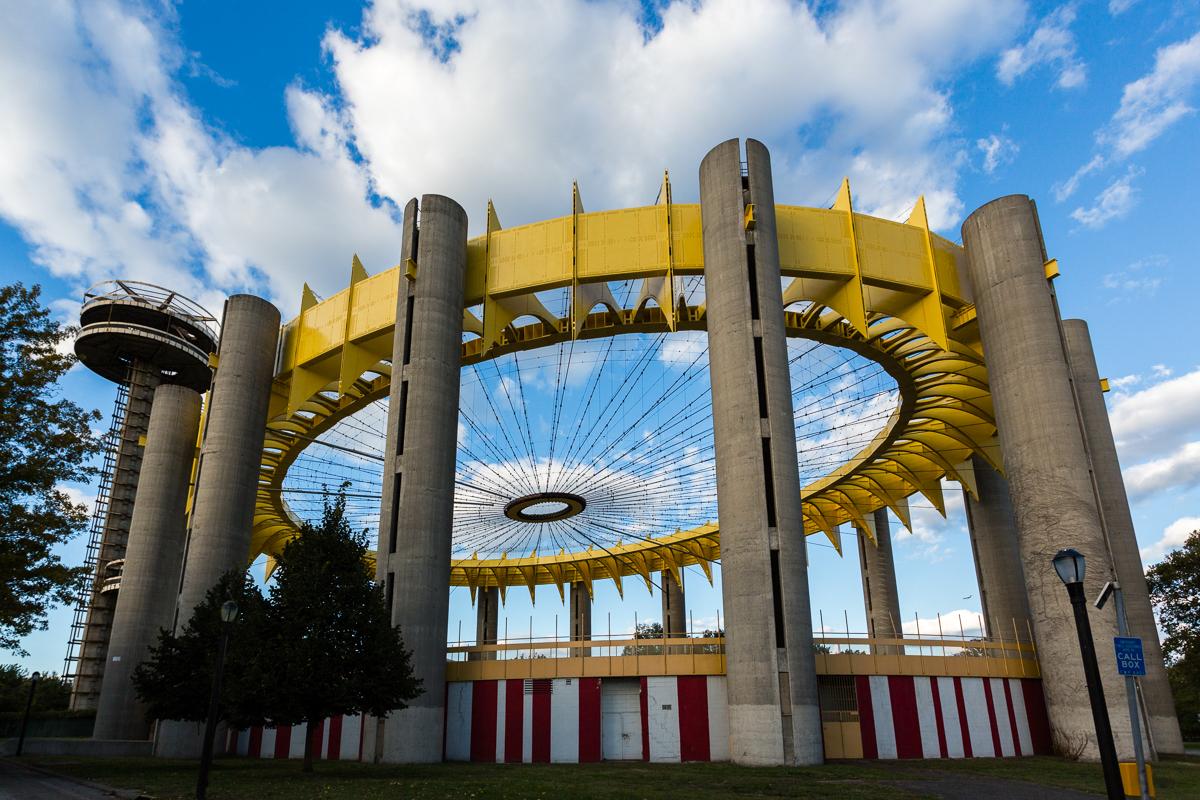
New York World’s Fair Philip Johnson Pavilion photo by Bob Borson
Designed by architect Philip Johnson and constructed for the 1964-65 World's Fair, the complex has been shuttered for decades (except for the former Theaterama, which is now the Queens Theatre). A lighting revamp heightens its visibility.

New York World’s Fair Philip Johnson Pavilion photo by Bob Borson
Architect Philip Johnson and artists Robert Indiana, Ellsworth Kelly, Robert Rauschenberg, and Andy Warhol are all associated with the New York State Pavilion, built for the 1964 New York World's Fair in Flushing Meadows-Corona Park. Warhol's work, 13 Most Wanted Men, sparked controversy before the Fair's opening in April 1964. Header Photo.

Philip Johnson's Glass House informs pool pavilion in Canada Pool
Architect Philip Johnson designed the New York State Pavilion for the 1964-65 World's Fair, which drew an estimated 51 million visitors to Flushing Meadows-Corona Park for a celebration of culture, technology, and "man's achievement on a shrinking globe in an expanding universe."

AD Classics New York State Pavilion / Philip Johnson Philip johnson
The Studio, a one-room workspace and library, was built in 1980 on the grounds of Philip Johnson's Glass House in New Canaan,. His firm's Pillars of Dreams pavilion in Charlotte, N.C., for.

Philip Johnson Pavilion Dumberton Oaks
Completed in 1949, the Glass House was the first design Johnson built on the property. The one-story house has a 32'x56' open floor plan enclosed in 18-feet-wide floor-to-ceiling sheets of glass.

Gallery of AD Classics New York State Pavilion / Philip Johnson 8
Published on April 22, 2014. Share. Philip Johnson's "iconic" New York State Pavilion has been listed as a "National Treasure" by the National Trust for Historic Preservation. This.

Philip Johnson folly Philip johnson, Architectural inspiration, Pavilion
Pavilion at Pavilion Kl up to 80% off with Agoda. Book Now! Pavilion at Pavilion Kuala Lumpur up to 80% off with Agoda. Book Now!

AD Classics New York State Pavillion / Philip Johnson Philip johnson
Philip Johnson's Glass House is an icon of American modernism. Inspired by Mies van der Rohe's Farnsworth House, the New Canaan residence has a glass exterior and lacks interior walls, a significant departure from traditional house design.Johnson's work as an architect and critic popularized International Style modernism in the United States, and his Glass House is recognized as one of.

philip johnson, pavilion Bing Images Philip johnson, Pavillion, New
It was designed in 1962 for the 1964 New York World's Fair by architects Philip Johnson and Richard Foster, with structural engineer Lev Zetlin . Architecture Attractions and Geographical Features of Flushing Meadows-Corona Park [Interactive fullscreen map + nearby articles] view talk edit

Dumbarton Oaks PreColumbian pavilion, Philip Johnson / As early as
Philip Johnson's iconic New York State Pavilion opened to hundreds of visitors for its 50th anniversary. By Ian Volner Connie Zhou

Phillilp Johnson The Lake Pavillion Architecture Project, Modern
Philip Johnson, (born July 8, 1906, Cleveland, Ohio, U.S.—died January 25, 2005, New Canaan, Connecticut), American architect and critic known both for his promotion of the International Style and, later, for his role in defining postmodernist architecture. Ludwig Mies van der Rohe and Philip Johnson: Seagram Building

Important Inspiration Philip Johnson Architecture
In 1964 the largest map pavement since the 6th century Madaba floor mosaic was realized by famed American architect Philip Johnson for the New York State Pavilion at the New York World's Fair. Known as the "Tent of Tomorrow," the twelve-story open-air elliptical pavilion became the symbol of the fair and for its main floor, Johnson.

Gallery of AD Classics New York State Pavilion / Philip Johnson 16
Philip Johnson's iconic New York State Pavilion in Flushing Meadows-Corona Park was built for the 1964-65 World's Fair, but has struggled in recent decades to find its purpose.

Gallery of AD Classics New York State Pavilion / Philip Johnson 17
Philip Johnson, who lived in the Glass House from 1949 until his death in 2005, conceived of it as half a composition, completed by the Brick House. Both buildings were designed in 1945-48. Since its completion in 1949, the building and decor have not strayed from their original design.

Revive Philip Johnson's New York State Pavilion in this National Trust
The Pavilion holds a great many surprises, and its best days may be yet to come. Designed by modernist icon Philip Johnson, the Pavilion was saved from the fate of many of the venues in the World's Fair.But it's only been used sporadically over the past 50 or so years, and the fear of further deterioration is always present.

Ideas competition for Philip Johnson's New York World Fair pavilion
New York State Governor Nelson Rockefeller commissioned architect Philip Johnson to design the New York State Pavilion, instructing him to design what would be the largest and tallest pavilion at the Fair.